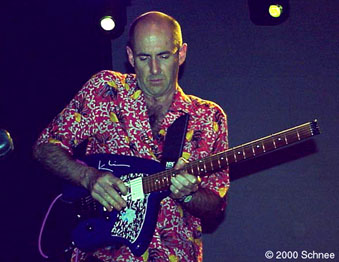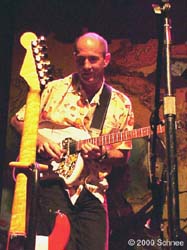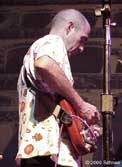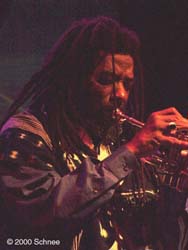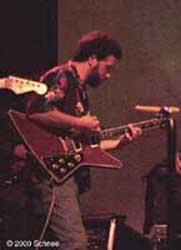|
Yo
HK! An Interview With |
|
by Bret Heisler and Rob Lucente ©2000 www.philzone.com and www.2012productions.com All photos ©2000 Schnee (Kristen Schneeloch) and Rob Lucente, Philzone.com and 2012productions.com. All rights reserved. This
interview or any photos included may not be reprinted anywhere
in Henry Kaiser, a prominent figure in the Grateful Dead's extended family, has taken music to new improvisational levels with many musicians in the Bay Area, through North America, and in cultures in many corners of the world. While appreciating the merits of world muscians present and past, Henry strives to experiment with the unknown in order to create something unique and in the moment. One of his latest projects, Yo Miles!, employs the improvisational methods used by Miles Davis specifically between 1972 and 1975 to "open a secret door into another universe." Recently, Philzone.com had the pleasure of speaking with Henry Kaiser about his many musical explorations - growing up with the Grateful Dead, contributing with many other musicians over the years including, most recently the Yo Miles! band, Phil Lesh and The David Nelson Band, and many more. Be sure to check out a few of his 160+ albums and don't miss his rare live performances! This is how it went... PZ: Your involvement with the Grateful Dead has been very unique. You’ve worked with the Dead and a lot of the musicians in the Grateful Dead community, but you started out as a fan – a listener – you must have a very interesting perspective of the whole scene. (hear the following in RealAudio) HK: Well you know I grew up with the Grateful Dead before I ever played guitar. I never touched a guitar until I was twenty years old in 1972. Before that, I’d been going to see the Grateful Dead since 1966 as a kid. I’d been to an Acid Test at the Longshoreman’s Hall and I saw a lot of those things and I appreciated a number of things about the Grateful Dead. I appreciated that they were really improvising, they were taking chances, they were being experimental, they were being eclectic, they were taking their musical ideas and ways of working from a lot of different places and putting them together in novel ways that nobody had ever done before. The Dead were really cooperative in the way they worked to make music together, and they had a respect for their audience and they wanted to treat their audience well.
One
day I asked Weir if he wanted to do something with me and he
agreed. I was over at Garcia’s house a number of different times
for different reasons and asked him to be in this British documentary
on improvisation that I was an advisor to and I brought guys
from Madagascar over to play at his house with him and open
for him and Grisman at the Warfield. I met Bob Bralove and started
to go sit on stage next to him because I really enjoyed watching
Dead shows from that perspective. While I had not kept an active
eye on the Grateful Dead for the last decade or so before that
– PZ: Tell us the story behind that show with Weir in Japan. (In the band, The Valentines, Henry played with Bob Weir, Vince Welnick, Bobby Vega, and Prairie Prince August 27, 1994 in Tokyo). HK: I don’t fully remember, but a Japanese promoter who knew me asked me if I could bring some rock stars over for this special big city festival gig. So I said, "Sure, I’ll go ask some guys from the Grateful Dead" and I asked them and they said, "Yeah." PZ: And then you did one more Valentines show in.... HK: ...Yeah, we did one show at the Fillmore on Valentines Day '95. I played with Weir at the Sweetwater a bunch of times and for some other occasions too. Perhaps the best show we have ever done together was the wake for Dick Latvala at the end of last summer. That was truly amazing and magical. Dennis McNally called me up a day or so before the wake and put me in the bandleader's seat. (Lesh was out on the road and only Mickey and Bob were around from the Dead) I knew Dick and I knew his favorite songs and shows and so I did quite a bit of homework so that we could quote some of his historically favorite jams (Feelin' Groovy Jam, Mind Left Body Jam, Other Spanish One Jam, etc). Weir, Hart, [Bob] Bralove, [Jeff] Chimenti, [Jay] Lane, [Gregg] Anton, and [Bobby] Vega turned up to play. No rehearsal - but it was magically easy to connect with the music and connect the audience with the music too. We played after a long and moving tribute to Dick, with 100's of folks each speaking out in turn about him. My favorite moment was standing next to Weir, facing Mickey, in the middle of the first set and saying to Mickey, "OK, Saint Stephen" and Mickey saying, "Saint Stephen? That's got a lot of arrangement details. Does the band know that?" I smiled and said, "No, they don't know it at all." Mickey said, "But, uh…, maybe we shouldn't try to…" and Weir interrupting with, "1-2-3-4" and us both smiling and starting the song anyway. That was a great feeling of jumping off past the point of no return. There were some ragged mistakes - but the spirits were there in spades for that song - as they were for most of that night. The board tapes are a little rough sounding, but Don from Ultrasound and myself keep trying to clean them up a bit before they finally leak out into the rest of the universe. The tapes don't really communicate the special magic and love that filled the Phoenix Theater [in Petaluma] that night. You really had to be there to understand. Dick Latvala you are missed and loved by many! PZ: Several hundred fans were lucky enough to catch one or both of the two Yo Miles! gigs at the Fillmore – one earlier this month (see the complete March 4th setlist and band member listing here) and one back in the fall. How was Yo Miles! conceived?
(hear the following in RealAudio) Miles kind of pointed to a secret door into another universe and he’d go through it every night when he played a concert and come back and he and the band would bring and show all this weird stuff they found to the audience. Nobody has been through that door much since then. We’re just trying to open that same door and let in what comes through. What we do is not like most of the tributes to the Miles Davis Jazz Quintet where they try to do what Miles did or stuff that sounds like that. Instead we use the system they used and go through this magic door into the other world and bring back something totally different we’ve never seen before – that’s our goal. So it’s a different kind of tribute than most – it’s a tribute to the spirit, and the method, and the creativity, not to the product that Miles made.
|
